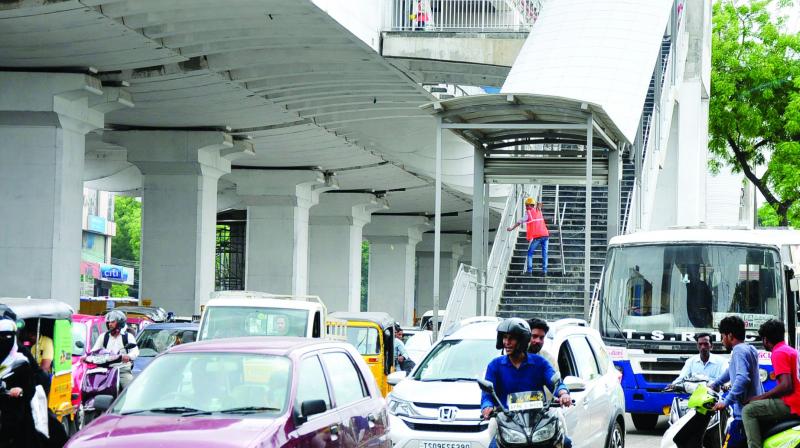Hyderabad Metro Rail: Staircases to order or chaos?

Hyderabad: Two stretches of the much awaited Hyderabad Metro Rail Nagole to Mettuguda and Miyapur to SR Nagar are nearly all built out. Will they help commuters travel hassle-free and safely? Will they help reduce the number of vehicles on the roads, and therefore traffic congestion?
The success of the Metro on these counts depends not just on trains running frequently but also on the whole experience of travelling by Metro. That may well be wh-ere Hyderabad soon discovers that it has stumbled badly.
Consider this: The Metro’s giant pillars stand along the medians of city roads, and thus right in the path of motorists. This design is unlike that of any other Metro system, such as in Bengaluru and Chennai.
Not only do the pillars confuse motorists and drastically reduce the motorable space, the traffic police have declared a number of these spots nearly 200, to be accident-prone, a fear that has come true all too often in recent weeks.
Now, as D-Day approaches for Metro services, we may be in for more nasty surprises. At many stations, such as YMCA crossroads, Rasoolpura, Beg-umpet, SR Nagar and Malakpet, it’s not just the pillars in the middle of the road, even the station staircases are bang in the middle, further shrinking the roads around them into what are likely to prove traffic bottlenecks.
Ask HMR officials about these, and they will tell you that everything has been thought of that there will be orderly movement of both traffic and Metro commuters because they have designated pick up and drop points on ‘service roads’ around Metro stations with access control railings all along, where cars, cabs and autos would go about their business.
But picture this: A Metro train will arrive and depart at a station every five minutes or so, and hundreds of people will be rushing in or out of the station each time, making their way through traffic on roads. And there will be hundreds of two-wheelers, cars and autos bringing them in or waiting to take them away, some wanting to continue on the ‘service roads’, some wanting to join traffic on the main carriageways, some wanting to take a U-turn to go in the opposite direction, and so on. Does it sound like anybody’s going to have an easy time around Metro stations!
But HMR officials have a ready answer they expect a 40 per cent reduction in road traffic once Metro services start, and so, they say, there should be no traffic jams and chaos! It’s an assumption that hasn’t quite worked in Delhi or Bangaluru, where Metro systems are already operating across those cities.
Press HMR further, and they reveal that they have constituted a committee, with traffic experts and transport engineers, to monitor bottlenecks, Metro junctions, pillars and staircases, and come out with solutions to traffic problems that will arise once the services start.
Clearly, if a bit late in the day, HMR officials are worried. And they have reasons to be. Says Hyderabad Traffic DCP A.V. Ranganath, “We have done a survey along with GHMC engineers and identified 191 places where these Metro pillars, staircases and stations are right on the road and obstructing traffic. We have given the report to HMR and they have formed a committee to suggest solutions.”
One proposal is to build multi-level parking facilities at 32 locations, says HMR MD N.V.S. Reddy.
The traffic police has also proposed that designated stands for autos, two-wheelers, cars, buses between Metro stations and catchment area-s would help reduce traffic. on the roads.
Traffic Joint Commissioner Dr V. Ravinder says, “It may be advisable to reduce RTC bus services on routes served by the Metro to reduce traffic on the roads. Instead, they should be put on radial routes linking to a central point.”
He also expects the number of taxis to fall once the Metro rolls out as two lines cater to the IT corridor.
The moot question is, can these assumptions and late proposals overcome the faulty design of this elephantine project?
Learn from other cities
In Chennai
All stations are on the side pavements. A vestibule takes commuters to the pavement, where they take the stairs into and out of the station.
Most stations do not have parking space, with autos and taxis using the roads nearby to park. This causes traffic jams, especially at linking stations.
The main line into town will have mostly underground stations. But there, too, last-mile connectivity is an issue.
In Bengaluru
Stations are on the side pavements. Traffic and pedestrian movement under the stations are well-regulated.
There is parking space for Metro commuters at many but not all stations.
In Kochi
Metro pillars are in the middle of the road, but the entry are exit are on the side pavements.
The pillars have helped divide the roads into two lanes in each direction.
Last-mile connectivity issues remain unresolved.

